 |
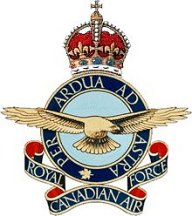 |
 |
 |
 |
 |
|
OLD ENOUGH TO DIE by Floyd Williston Winnipeg Free Press ~ Sunday, May 1, 2005 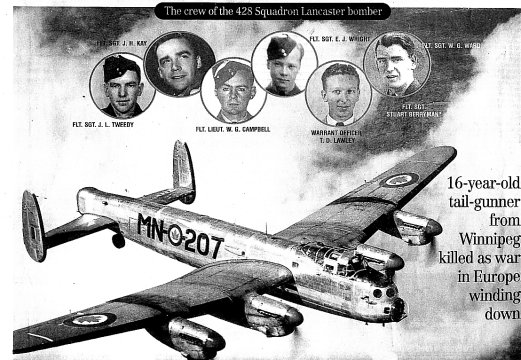
"I noticed the aircraft going down in a spiral dive with white vapour trails or smoke coming from the starboard engine" . |
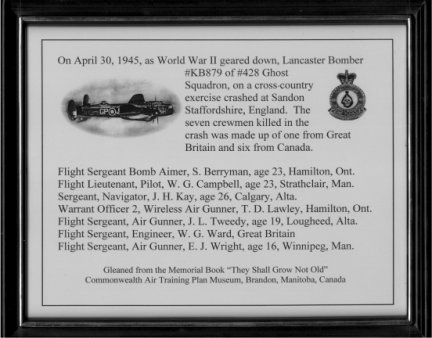
Memoriam Plaque at Brandon's Commonwealth Air Training
Plan Museum
Sixty years ago, as the war in Europe was winding down, a 428 Squadron Lancaster bomber crashed during a routine training flight over the English countryside. All seven crew members died -- including two Manitobans. One of the two was a 16-year-old tail-gunner from Winnipeg who is believed to be the youngest aircrew member killed in the Second World War. The April 30, 1945, crash happened at a time when thousands of Canadian airmen overseas were counting the days until they'd be home with their families. There had been rumours of a possible early repatriation for some units, including the 428 Squadron. There was even talk of ferrying their Lancasters home, or perhaps a posting in the Middle East.Flight Sgt. Ted Wright, son of a Winnipeg RCMP officer who himself was a former pilot for England's Royal Air Force during the First World War, added fuel to the speculation in a letter to his mother dated April 25, 1945.
"I've changed squadrons and am now with a RCAF 428 'Ghost' Squadron. Well, Mom, I've been a flight sergeant for a few months and never knew it. I just found out today. Well, Mom, I'm not sure but I thing this squadron is going to the east. I wonder if you could send me a Sheaffer's pen and pencil set. I lost a fellow's pencil and want to get him another. Write soon. (Ted)"
Five days later, the boyish-faced tail-gunner was dead. So, too, was his skipper, Flight Lieut. W.G. "Billie" Campbell, of Strathclair, Man.
The relative calm of that warm spring Monday of April 30 was suddenly disturbed when two four-engine bombers appeared in the scattered clouds that filled the mid-morning sky. The aircraft had taken off at 10:59 a.m. from 428 Squadron's base at Middleton St. George, Durham. It was now well within sight of RAF Station Hixon.
Behind the controls of Lancaster KB879 was 23-year-old Campbell. Word had come down that he was one of the pilots scheduled to fly his Lancaster back to Canada, making this cross-country training practice even more significant.
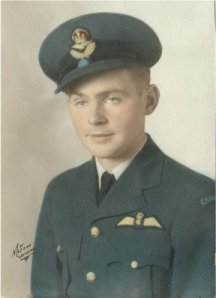
F/L William Gavin CampbellCampbell was hopeful that his 20-year-old flight engineer would accompany him across the Atlantic. Ward had been with the crew since it linked up at No. 26 Operational Training Unit in Wing, Buckinghamshire. He was also a pilot.
Continually checking his navigation charts since the bomber became airborne was Sgt. Johnnie Kay, a former member of the RCMP. Kay, 26, was the only married man in the crew. His wife and three-year-old son lived in Brooks, Alta.
Also critical to the training exercise was the wireless operator, 20-year-old Warrant Officer Tom Lawley. He was already in contact with RAF Station Hixon to confirm the arrival of KB879 in the area. Lawley, formerly a machinist apprentice, was a native of Hamilton, Ont.
.....
![[8] F/S Edward James Wright (16-year-old Lancaster Air Gunner]](uk1320.jpg)
Flight Sergeants Ward and Wright
[9] F/S Walter Graham Ward (RAF Lancaster Engineer)
[8] F/S Edward James Wright (16-year-old Lancaster Air Gunner]Flight sergeants Lester Tweedy, 19, from Lougheed, Alberta, and Wright, 16, both air-gunners, were instructed to remain alert throughout the training flight because Luftwaffe intruders into English air space were still an occasional threat.
The seventh member of the crew was Flight Sgt. Stuart Berryman, another Hamiltonian and an air bomber who had just celebrated his 23rd birthday.
The pilot of the second Lancaster, flying slightly above, was alarmed at the erratic behavior of KB879. His tail-gunner, Sgt. Ronald Cranston, had alerted him to this after they'd been in the air awhile. Flying at an altitude of 18,000 feet, Cranston had a relatively clear view of Campbell's aircraft, three thousand feet below.
"At first it appeared to be flying with a side-slipping motion," he later told investigators. "After another 20-25 minutes I noticed the aircraft going down in a spiral dive with white vapour trails or smoke coming from the starboard engine. It appeared that nothing was done to counteract the dive. No parachutes appeared to open and no part of the aircraft seemed to fall off."
For some unknown reason, communication between the two aircraft was cut. There was now no way of knowing what was transpiring inside KB879. Had the skipper lost control? If so, why? Was there an oxygen problem? Was it a mechanical or a man-made problem. We'll never know for sure.
Eyewitnesses on the ground had somewhat different and sometimes conflicting stories. John Kent, a student at a local school, stated in a booklet subsequently published about the crash that the plane "went over the building and then very low over Grove Farm. It seemed to swing around and clipped nearby trees, crossing A51 highway, and bursting into flames as it hit the ground."
Another local resident reported that the main body parts, the fuselage and wings, landed in a corner of the Burston Cottage Farm, near the highway. The tail section, which had split off, rolled across the highway and hit a farm building. Wright was ejected and later found, as if in a sitting position, some distance from the aircraft. He was the first casualty to be identified.
Former Sandon School
Peter Betts, a Sandon School student, watched in disbelief as "a big wheel bounced towards the Williams Farm" according to the booklet he heard a huge thud that actually rattled the school. He assumed this was when the plane crashed. Then Betts saw a massive cloud of smoke.
He later recalled walking past the crash site after school Betts saw bodies being taken away while the charred remains of the aircraft were piled onto flatbed trucks.
The subsequent investigation, to which Sgt. Cranston provided his statement, and the RAF "Report on Flying Accident" concluded that the Lancaster broke up in the air, likely as a result of the pressure and stress from the vertical dive. First, the wing tips came away, followed by parts of the fuselage and the outer port engine. What remained spiraled down, hit the ground and caught fire.
The oxygen supply cock was found to be partially closed. This may have caused some crew members to black out. An additional finding was that, as on a previous occasion, the autopilot was faulty. But this time it was a fatal flaw, causing loss of control and loss of life.
The air force's death cards for all seven airmen were identical. They died of multiple injuries.Within days, the dreaded "We regret to inform you" telegrams began arriving. The bereaved families questioned why their sons, who were so close to coming home, would now never return. They were devastated.
In Winnipeg, RCMP Supt. James Wright got the bad news at work, and then hurried home to break it to the family Though he was able to comfort them, he personally never got over the loss of his son, Ted.
The funeral for six of the crew took place at the Regional Cemetery at Chester (Blacon) on the afternoon of May 4 at 2 p.m. Full service honours were accorded, with the coffins carried by air force personnel. A firing party was present, the coffins were covered with the Union Jack and the Last Post was sounded at the end. Photographs of the service were sent to the next of kin.

Only Flight Sgt. Ward can be said to have returned home. He was buried with full military honours in his native Selkirk, Scotland.
One month after the tragic incident that snuffed out the lives of Campbell and his crew, the first group of Lancasters from 428 Squadron returned to Canada. On the last day of May, 15 aircraft lifted off from Middleton St. George and headed across the Azores toward Yarmouth, Nova Scotia.
An animated crowd of RAF and RCAF brass were joined by other air force personnel to wish the crews God speed.
One Lancaster aborted shortly after takeoff. Another crashed near the Azores, but there were no casualties. All other ground personnel and non-active aircrews of 428 Squadron returned to Canada by sea.
In 1946, a letter from Commonwealth War Graves Commission arrived at the Wright residence. The CWGC was preparing an inscription for a stone tablet to be placed on Teddy Wright's grave. The reply from Wright's mother, Alfreda, surprised commission officials. Wright had been only 16 when he died.On his original attestation papers, Wright had given his date of birth as Nov. 7, 1925. But his mother provided the commission with his actual date of birth. As stated on his birth certificate, he was born in Montreal on Nov. 7, 1928
Edward James Wright lived with his family in Montreal and in Ottawa until May 1937, when his father was posted to various locations in the Maritimes by the RCMP.
Five days before Canada declared war on Germany, 10-year-old Teddy Wright was just beginning Grade 5 classes at Sir Charles Tupper School in Halifax. A few months later, he and his three siblings (Ada, Patricia and Richard) registered at West Kent School in Charlottetown. Although he had the intellectual capacity, Teddy was a free spirit and resented being restricted in any way. From time to time he would just take off, doing odd jobs to earn pocket money.
Sister Patricia, known as Patsy, believes that while in the Maritimes, Teddy tried to join the navy or merchant marine, but his father would have none of it.
Teddy worked for a few months in the winter of 1943 for the Knights of Columbus Canteen in Halifax before following the family to Winnipeg when they moved here in May, 1943. It was Supt. Wright's final RCMP posting before his retirement in 1946. The family lived at 191 Yale Ave. and the twins attended Grosvenor School. Ada was married in Winnipeg and lived on Stafford Street.
On Nov. 18, 1943, Teddy took a bus, or perhaps walked, from Yale Avenue to the No. 6 RCAF Recruiting Station.
Teddy Wright and mother Alfreda ~
Home on leave 1944Instead of granting him an interview, the recruiting officer should have sent Wright straight home to his mother, because the self-confident, fair-haired youth had only recently celebrated his 15th birthday, and the minimum age for enlistment was 18. It remains a mystery how the relatively small-framed, 129-pound, 5-6 teenager was able to fool the recruiting officer.
Teddy's claim to prior service was two months in the reserves. For work experience, he listed three months as a cook in Halifax with the CNR. From that point on the RCAF listed his occupation as "cook." When asked, he immediately produced a National Registration Certificate that showed his age to be 18.
"Teddy's medical examination went well, finding no lingering effects from the scarlet fever he'd had as a child. In 1939, he'd almost died from complications related to acute appendicitis.
Young Wright had come to the recruitment office despite the opposition of his father. But Teddy had threatened to run away, or even change his name if needed, unless he received parental approval to apply for service in the RCAF. Convinced that his son would not be accepted, Wright Sr. reluctantly agreed to let him apply.
To his father's astonishment, Teddy passed muster, and within a few days was on his way to No. 3 Manning Depot in Edmonton. Early in the new year he was sent to McGill University in Montreal for a bit of academic upgrading to supplement his Grade 8 education. He did well at McGill.
Fifteen months later, after successfully completing air-gunner training, the now-16-year-old child-soldier was posted to England. He spent part of his embarkation leave in Winnipeg.
Patricia (Patsy) Flowers now lives in Ontario, but in July 1944 she was a nine-year-old, heartbroken little sister, waiting with her other in Winnipeg's CN Station. She remembers going there to wave good-bye to her oldest brother. He was passing through the city before "going overseas" -- leaving home for the last time. She was excited about the bagged lunch her mother had made for Teddy.
Teddy Wright with twin siblings,
Dickie and Patsy ~ Winnipeg 1944In an interview last week, Patricia said that even now, 60 years after his untimely death in 1945, she remembers him as a handsome knight in air force-blue armour. In her mind, he was a grown man -- and her hero. Yet he was only six years her senior, and she has always wished his RCAF application had been rejected. "But as I remember Teddy, he would have found another way."
Teddy landed in England on July 27, 1944. Posted to 26 Operational Training Unit (Wing, Buckinghamshire), he flew in Wellingtons. During that time, according to his logbook, he experienced more than one operational flight over German-occupied Europe.
His first time up with Flight Lieut. Campbell's crew was in Wellington 791 -- on Dec. 29, 1944. Campbell had also joined the RCAF in Winnipeg, more than two years before Wright, in June 1941. He had a Grade 11 education, and his primary work experience was on the family farm in Strathclair. His proficiency as a pilot was recognized when he was awarded the King's Commendation.
Campbell and Wright were subsequently transferred to 428 Squadron, which flew Lancaster bombers. It is doubtful if anyone in their Lancaster crew knew that their tail gunner was just a boy. Teddy joined them at the popular local pubs -- more than holding his own.
Few people are aware that more than 2,500 "child-soldiers," 16 years of age and even younger, are buried in military graves registered with the Commonwealth War Graves Commission. Well over 100 are Canadian, mostly from the First World WAr.
Perhaps recruiting officers during the Second World War were a bit more concerned about allowing underage applicants to slip through their fingers. In 1940, the Canadian government introduced the National Registration Certificate. All Canadians 16 years of age and older were obliged by law to carry this certificate with them at all times. The penalty for non-compliance was $20. It could also be used as proof of birth date -- but the underage would-be soldiers still managed to slip through.
Roy Hadwyn (air-gunner), of Lindsay, Ont., was one Hadwyn was tall for his age. He joined the RCAF at the age of 15, and a year later was an integral part of a Halifax bomber crew. When discovered, he was shipped back to Canada, but wasn't discharged.
Another was mid-upper-gunner Flight Sgt. Eric Fedi of Winnipeg, who also joined the RCAF at 15 and was a seasoned 17-year-old battle veteran when he was killed on Sept. 7, 1943.
James and Alfreda Wright and their twin children, Richard and Patsy, left Canada in 1946 and settled in Brighton, England. James Wright made a personal visit to the Blacon Cemetery, and to Sandon. He met several people who had witnessed the crash of KB879 a year earlier, including Herbert Halfpenny, who gave Wright a photograph which purported to show Teddy's body outside the crashed Lancaster.
The family returned to Canada five years later, but not before visiting the cemetery together. James Wright died in Toronto in 1957, and Alfreda Wright passed away in Florida in 1974. She was still carrying in her wallet the last letter her son Teddy had written from overseas. Richard died in 1973. Only Patricia (Patsy) and Ada are living.
..
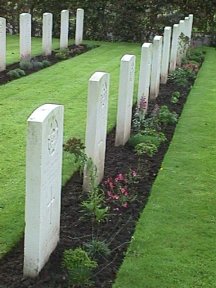
Louise Campbell-Hillman and son visit the graves of the KB879 crew
Blacon Cemetery, Chester ~ 1999
On Aug. 28, 1999, a memorial to KB879 was unveiled at the crash site in Sandon. In attendance were members of the Ward, Wright and Campbell families.
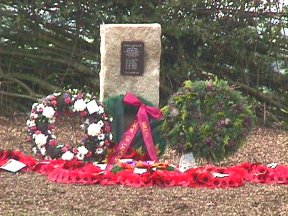
Memorial to the Crew of Lancaster KB879 at the crash site near Sandon |
![[15] Memorial Plaque with Names of the Lancaster Crew](uk1314.jpg)
Memorial Plaque with Names of the Lancaster Crew |
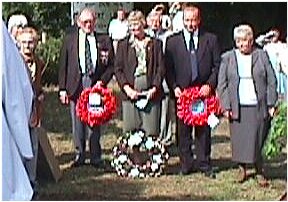
Families of the Fallen prepare to lay wreaths on the Crash Site Memorial ~ 1999 |
Patsy Flowers was thrilled to speak with Billie Campbell's sister, Louise Hillman, and her son, Bill. Also present was Evelyn Tough, cousin of Graham Ward. She also met Ken Halfpenny, whose father had befriended her dad 53 years earlier during his 1946 visit to Sandon.
![[1] Legion Colour Party at Crash Site marked by RAF, Union Jack & Canadian Flags](uk1201.jpg)
Legion Colour Party at Crash Site marked by RAF, Union Jack & Canadian Flags |
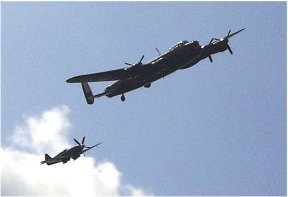
Battle of Britain Memorial Fly-Past Lancaster and Spitfire |
The Battle of Britain Memorial Fly-Past, a Lancaster and a Spitfire, joined in tribute to Flight Lieut. Campbell and his crew.Two lakes in Northern Manitoba have been named in honour of Wright and Campbell -- Edward Wright Lake, northeast of Windy Lake, and Campbell Lake, west of Waskaiowaka Lake.
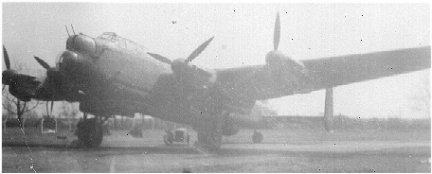
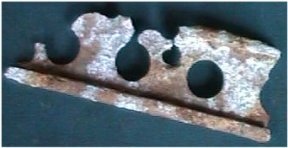
Piece of Lancaster Wreckage
| Floyd Williston is a Winnipeg researcher / writer. He is author of two books -- Johnny Miles, Nova Scotia's Marathon King, and Through Footless Halls of Air (Stories of a Few of the Many Who Failed to Return). This article is based on his soon-to-be published book, Teddy Boy: Too Young to Fly, Not Too Young to Die. He is also completing a book on Canadians and Americans in the Battle of Britain. |
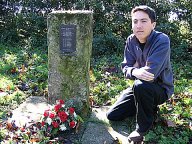
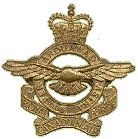
 .................
.................
SITE NAVIGATION CHART
Part I: The Home Front


BACK
TO THE WWII RCAF TRIBUTE SITE

Navigation
Chart to the Hillman WWII Tributes
www.hillmanweb.com/war
|
WWII Remembered www.hillmanweb.com/war/asyouwere |
Ex-Air Gunners Association www.hillmanweb.com/airmuseum/mag |
![]()
![]()
![]()
Webmaster:
William G. Hillman
BILL
& SUE-ON HILLMAN ECLECTIC STUDIO
HILLMAN
EDUTECH PROJECT AT BRANDON UNIVERSITY
Visit all the Hillman War
Years Tribute Sites at:
http://www.hillmanweb.com/war
Copyright 2005/2011/2021
William
G. Hillman
Bill and Sue-On
Hillman Eclectic Studio